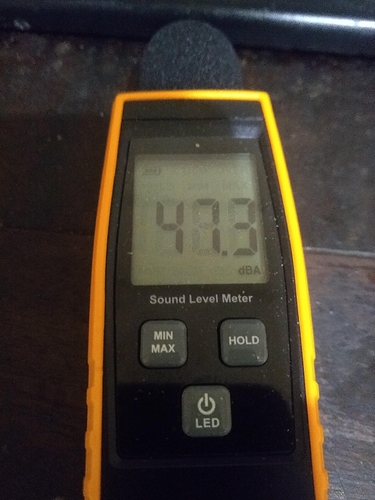This is a far and near sample reading at normal volume with settings from above that have both alc and noisegate enabled:
numid=12,iface=MIXER,name='Headphone Playback ZC Switch'
; type=BOOLEAN,access=rw------,values=2
: values=off,off
numid=11,iface=MIXER,name='Headphone Playback Volume'
; type=INTEGER,access=rw---R--,values=2,min=0,max=127,step=0
: values=126,126
| dBscale-min=-121.00dB,step=1.00dB,mute=1
numid=17,iface=MIXER,name='PCM Playback -6dB Switch'
; type=BOOLEAN,access=rw------,values=1
: values=off
numid=57,iface=MIXER,name='Mono Output Mixer Left Switch'
; type=BOOLEAN,access=rw------,values=1
: values=off
numid=58,iface=MIXER,name='Mono Output Mixer Right Switch'
; type=BOOLEAN,access=rw------,values=1
: values=off
numid=41,iface=MIXER,name='ADC Data Output Select'
; type=ENUMERATED,access=rw------,values=1,items=4
; Item #0 'Left Data = Left ADC; Right Data = Right ADC'
; Item #1 'Left Data = Left ADC; Right Data = Left ADC'
; Item #2 'Left Data = Right ADC; Right Data = Right ADC'
; Item #3 'Left Data = Right ADC; Right Data = Left ADC'
: values=0
numid=19,iface=MIXER,name='ADC High Pass Filter Switch'
; type=BOOLEAN,access=rw------,values=1
: values=off
numid=36,iface=MIXER,name='ADC PCM Capture Volume'
; type=INTEGER,access=rw---R--,values=2,min=0,max=255,step=0
: values=195,195
| dBscale-min=-97.50dB,step=0.50dB,mute=1
numid=18,iface=MIXER,name='ADC Polarity'
; type=ENUMERATED,access=rw------,values=1,items=4
; Item #0 'No Inversion'
; Item #1 'Left Inverted'
; Item #2 'Right Inverted'
; Item #3 'Stereo Inversion'
: values=0
numid=2,iface=MIXER,name='Capture Volume ZC Switch'
; type=INTEGER,access=rw------,values=2,min=0,max=1,step=0
: values=0,0
numid=3,iface=MIXER,name='Capture Switch'
; type=BOOLEAN,access=rw------,values=2
: values=on,on
numid=1,iface=MIXER,name='Capture Volume'
; type=INTEGER,access=rw---R--,values=2,min=0,max=63,step=0
: values=32,32
| dBscale-min=-17.25dB,step=0.75dB,mute=0
numid=10,iface=MIXER,name='Playback Volume'
; type=INTEGER,access=rw---R--,values=2,min=0,max=255,step=0
: values=255,255
| dBscale-min=-127.50dB,step=0.50dB,mute=1
numid=23,iface=MIXER,name='3D Filter Lower Cut-Off'
; type=ENUMERATED,access=rw------,values=1,items=2
; Item #0 'Low'
; Item #1 'High'
: values=0
numid=22,iface=MIXER,name='3D Filter Upper Cut-Off'
; type=ENUMERATED,access=rw------,values=1,items=2
; Item #0 'High'
; Item #1 'Low'
: values=0
numid=25,iface=MIXER,name='3D Switch'
; type=BOOLEAN,access=rw------,values=1
: values=off
numid=24,iface=MIXER,name='3D Volume'
; type=INTEGER,access=rw------,values=1,min=0,max=15,step=0
: values=0
numid=33,iface=MIXER,name='ALC Attack'
; type=INTEGER,access=rw------,values=1,min=0,max=15,step=0
: values=5
numid=32,iface=MIXER,name='ALC Decay'
; type=INTEGER,access=rw------,values=1,min=0,max=15,step=0
: values=6
numid=26,iface=MIXER,name='ALC Function'
; type=ENUMERATED,access=rw------,values=1,items=4
; Item #0 'Off'
; Item #1 'Right'
; Item #2 'Left'
; Item #3 'Stereo'
: values=3
numid=30,iface=MIXER,name='ALC Hold Time'
; type=INTEGER,access=rw------,values=1,min=0,max=15,step=0
: values=6
numid=27,iface=MIXER,name='ALC Max Gain'
; type=INTEGER,access=rw------,values=1,min=0,max=7,step=0
: values=4
numid=29,iface=MIXER,name='ALC Min Gain'
; type=INTEGER,access=rw------,values=1,min=0,max=7,step=0
: values=0
numid=31,iface=MIXER,name='ALC Mode'
; type=ENUMERATED,access=rw------,values=1,items=2
; Item #0 'ALC'
; Item #1 'Limiter'
: values=0
numid=28,iface=MIXER,name='ALC Target'
; type=INTEGER,access=rw------,values=1,min=0,max=15,step=0
: values=2
numid=21,iface=MIXER,name='DAC Deemphasis Switch'
; type=BOOLEAN,access=rw------,values=1
: values=off
numid=42,iface=MIXER,name='DAC Mono Mix'
; type=ENUMERATED,access=rw------,values=1,items=2
; Item #0 'Stereo'
; Item #1 'Mono'
: values=0
numid=20,iface=MIXER,name='DAC Polarity'
; type=ENUMERATED,access=rw------,values=1,items=4
; Item #0 'No Inversion'
; Item #1 'Left Inverted'
; Item #2 'Right Inverted'
; Item #3 'Stereo Inversion'
: values=0
numid=45,iface=MIXER,name='Left Boost Mixer LINPUT1 Switch'
; type=BOOLEAN,access=rw------,values=1
: values=on
numid=43,iface=MIXER,name='Left Boost Mixer LINPUT2 Switch'
; type=BOOLEAN,access=rw------,values=1
: values=off
numid=44,iface=MIXER,name='Left Boost Mixer LINPUT3 Switch'
; type=BOOLEAN,access=rw------,values=1
: values=off
numid=9,iface=MIXER,name='Left Input Boost Mixer LINPUT1 Volume'
; type=INTEGER,access=rw---R--,values=1,min=0,max=3,step=0
: values=3
| dBrange-
rangemin=0,,rangemax=1
| dBscale-min=0.00dB,step=13.00dB,mute=0
rangemin=2,,rangemax=3
| dBscale-min=20.00dB,step=9.00dB,mute=0
numid=5,iface=MIXER,name='Left Input Boost Mixer LINPUT2 Volume'
; type=INTEGER,access=rw---R--,values=1,min=0,max=7,step=0
: values=0
| dBscale-min=-15.00dB,step=3.00dB,mute=1
numid=4,iface=MIXER,name='Left Input Boost Mixer LINPUT3 Volume'
; type=INTEGER,access=rw---R--,values=1,min=0,max=7,step=0
: values=0
| dBscale-min=-15.00dB,step=3.00dB,mute=1
numid=49,iface=MIXER,name='Left Input Mixer Boost Switch'
; type=BOOLEAN,access=rw------,values=1
: values=on
numid=53,iface=MIXER,name='Left Output Mixer Boost Bypass Switch'
; type=BOOLEAN,access=rw------,values=1
: values=off
numid=37,iface=MIXER,name='Left Output Mixer Boost Bypass Volume'
; type=INTEGER,access=rw---R--,values=1,min=0,max=7,step=0
: values=0
| dBscale-min=-21.00dB,step=3.00dB,mute=0
numid=52,iface=MIXER,name='Left Output Mixer LINPUT3 Switch'
; type=BOOLEAN,access=rw------,values=1
: values=off
numid=38,iface=MIXER,name='Left Output Mixer LINPUT3 Volume'
; type=INTEGER,access=rw---R--,values=1,min=0,max=7,step=0
: values=0
| dBscale-min=-21.00dB,step=3.00dB,mute=0
numid=51,iface=MIXER,name='Left Output Mixer PCM Playback Switch'
; type=BOOLEAN,access=rw------,values=1
: values=on
numid=35,iface=MIXER,name='Noise Gate Switch'
; type=BOOLEAN,access=rw------,values=1
: values=on
numid=34,iface=MIXER,name='Noise Gate Threshold'
; type=INTEGER,access=rw------,values=1,min=0,max=31,step=0
: values=20
numid=48,iface=MIXER,name='Right Boost Mixer RINPUT1 Switch'
; type=BOOLEAN,access=rw------,values=1
: values=on
numid=46,iface=MIXER,name='Right Boost Mixer RINPUT2 Switch'
; type=BOOLEAN,access=rw------,values=1
: values=off
numid=47,iface=MIXER,name='Right Boost Mixer RINPUT3 Switch'
; type=BOOLEAN,access=rw------,values=1
: values=off
numid=8,iface=MIXER,name='Right Input Boost Mixer RINPUT1 Volume'
; type=INTEGER,access=rw---R--,values=1,min=0,max=3,step=0
: values=3
| dBrange-
rangemin=0,,rangemax=1
| dBscale-min=0.00dB,step=13.00dB,mute=0
rangemin=2,,rangemax=3
| dBscale-min=20.00dB,step=9.00dB,mute=0
numid=7,iface=MIXER,name='Right Input Boost Mixer RINPUT2 Volume'
; type=INTEGER,access=rw---R--,values=1,min=0,max=7,step=0
: values=0
| dBscale-min=-15.00dB,step=3.00dB,mute=1
numid=6,iface=MIXER,name='Right Input Boost Mixer RINPUT3 Volume'
; type=INTEGER,access=rw---R--,values=1,min=0,max=7,step=0
: values=0
| dBscale-min=-15.00dB,step=3.00dB,mute=1
numid=50,iface=MIXER,name='Right Input Mixer Boost Switch'
; type=BOOLEAN,access=rw------,values=1
: values=on
numid=56,iface=MIXER,name='Right Output Mixer Boost Bypass Switch'
; type=BOOLEAN,access=rw------,values=1
: values=off
numid=39,iface=MIXER,name='Right Output Mixer Boost Bypass Volume'
; type=INTEGER,access=rw---R--,values=1,min=0,max=7,step=0
: values=5
| dBscale-min=-21.00dB,step=3.00dB,mute=0
numid=54,iface=MIXER,name='Right Output Mixer PCM Playback Switch'
; type=BOOLEAN,access=rw------,values=1
: values=on
numid=55,iface=MIXER,name='Right Output Mixer RINPUT3 Switch'
; type=BOOLEAN,access=rw------,values=1
: values=off
numid=40,iface=MIXER,name='Right Output Mixer RINPUT3 Volume'
; type=INTEGER,access=rw---R--,values=1,min=0,max=7,step=0
: values=2
| dBscale-min=-21.00dB,step=3.00dB,mute=0
numid=16,iface=MIXER,name='Speaker AC Volume'
; type=INTEGER,access=rw------,values=1,min=0,max=5,step=0
: values=4
numid=15,iface=MIXER,name='Speaker DC Volume'
; type=INTEGER,access=rw------,values=1,min=0,max=5,step=0
: values=4
numid=13,iface=MIXER,name='Speaker Playback Volume'
; type=INTEGER,access=rw---R--,values=2,min=0,max=127,step=0
: values=127,127
| dBscale-min=-121.00dB,step=1.00dB,mute=1
numid=14,iface=MIXER,name='Speaker Playback ZC Switch'
; type=BOOLEAN,access=rw------,values=2
: values=off,off
Near is 1m and far is 4.5 m. Excuse the dog paw sounds in the backgroud. The other noise you can hear is the mic picking up sounds from something my girlfriend is watching on her phone down the hallway in another room.
Near:
https://drive.google.com/file/d/1sYOM7rFpr9q7keAVey73cZuhrg0xlb_b/view?usp=sharing
Far:
https://drive.google.com/file/d/11no6UsZWwWYsf3kRc98HhD-9mMk6utMm/view?usp=sharing

